Childhood Obesity: A Public Health Issue and Recommendations
VerifiedAdded on 2020/02/24
|11
|3181
|107
Report
AI Summary
This report addresses the critical issue of childhood obesity, exploring its causes, prevalence, and public health significance. It highlights the shift from a time when childhood obesity was less prevalent to the current situation where factors like fast food, sedentary lifestyles, and technology contribute significantly to the problem. The report delves into the primary causes, including lack of physical activity and unhealthy diets, and identifies the at-risk population. It reviews evidence-based health promotion interventions, such as family-based behavioral treatments and primary care interventions, emphasizing their effectiveness in promoting healthy eating habits and increased physical activity. The report also examines existing gaps in policies, programs, and practices, particularly concerning preventive measures and early interventions. Finally, it provides recommendations for addressing childhood obesity, including encouraging parental involvement, promoting healthy eating habits, and increasing screening and interventions in primary care settings, as well as the importance of breastfeeding and addressing maternal weight gain during pregnancy.

Running head: CHILDHOOD OBESITY 1
Childhood Obesity
Student’s Name
Institution Affiliation
Date of Submission
Childhood Obesity
Student’s Name
Institution Affiliation
Date of Submission
Paraphrase This Document
Need a fresh take? Get an instant paraphrase of this document with our AI Paraphraser
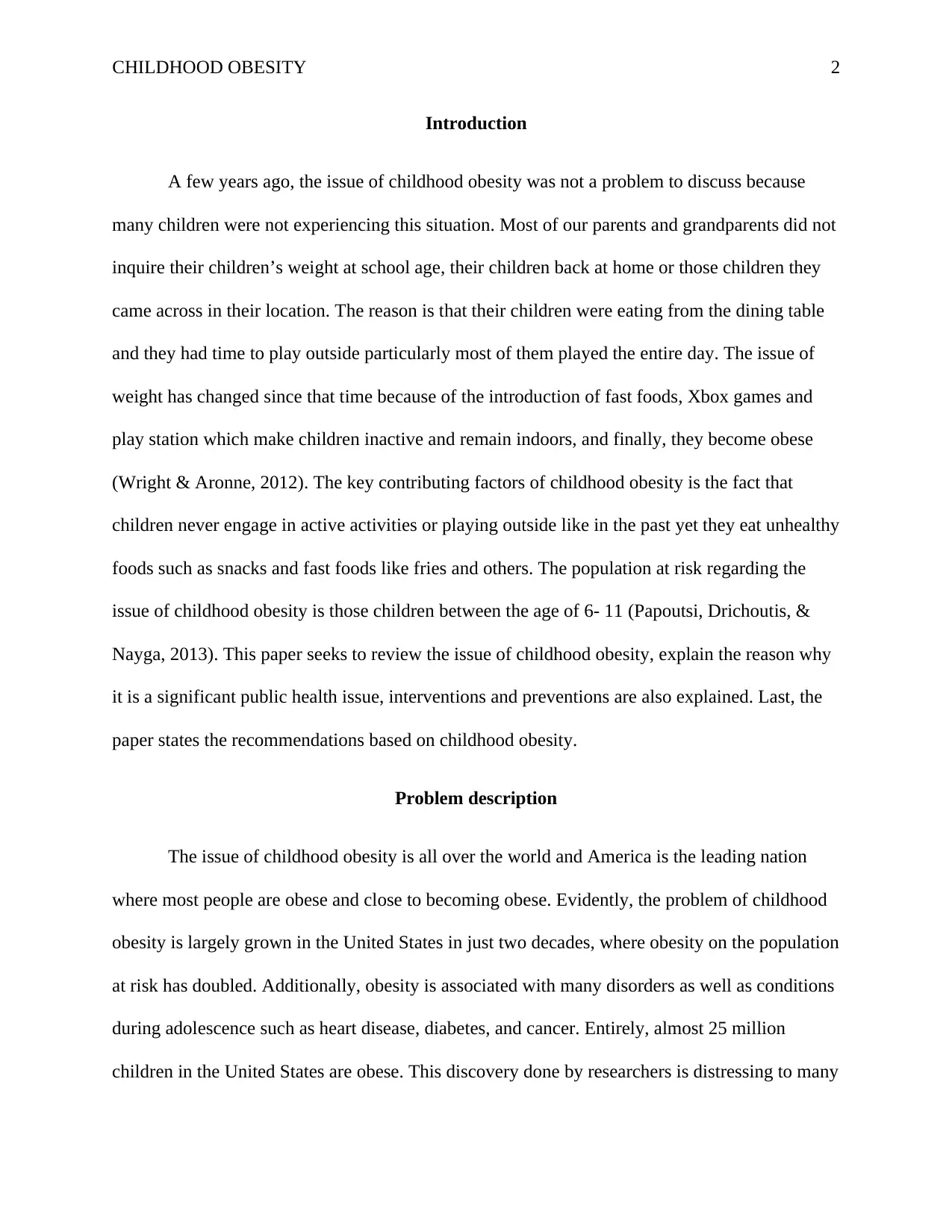
CHILDHOOD OBESITY 2
Introduction
A few years ago, the issue of childhood obesity was not a problem to discuss because
many children were not experiencing this situation. Most of our parents and grandparents did not
inquire their children’s weight at school age, their children back at home or those children they
came across in their location. The reason is that their children were eating from the dining table
and they had time to play outside particularly most of them played the entire day. The issue of
weight has changed since that time because of the introduction of fast foods, Xbox games and
play station which make children inactive and remain indoors, and finally, they become obese
(Wright & Aronne, 2012). The key contributing factors of childhood obesity is the fact that
children never engage in active activities or playing outside like in the past yet they eat unhealthy
foods such as snacks and fast foods like fries and others. The population at risk regarding the
issue of childhood obesity is those children between the age of 6- 11 (Papoutsi, Drichoutis, &
Nayga, 2013). This paper seeks to review the issue of childhood obesity, explain the reason why
it is a significant public health issue, interventions and preventions are also explained. Last, the
paper states the recommendations based on childhood obesity.
Problem description
The issue of childhood obesity is all over the world and America is the leading nation
where most people are obese and close to becoming obese. Evidently, the problem of childhood
obesity is largely grown in the United States in just two decades, where obesity on the population
at risk has doubled. Additionally, obesity is associated with many disorders as well as conditions
during adolescence such as heart disease, diabetes, and cancer. Entirely, almost 25 million
children in the United States are obese. This discovery done by researchers is distressing to many
Introduction
A few years ago, the issue of childhood obesity was not a problem to discuss because
many children were not experiencing this situation. Most of our parents and grandparents did not
inquire their children’s weight at school age, their children back at home or those children they
came across in their location. The reason is that their children were eating from the dining table
and they had time to play outside particularly most of them played the entire day. The issue of
weight has changed since that time because of the introduction of fast foods, Xbox games and
play station which make children inactive and remain indoors, and finally, they become obese
(Wright & Aronne, 2012). The key contributing factors of childhood obesity is the fact that
children never engage in active activities or playing outside like in the past yet they eat unhealthy
foods such as snacks and fast foods like fries and others. The population at risk regarding the
issue of childhood obesity is those children between the age of 6- 11 (Papoutsi, Drichoutis, &
Nayga, 2013). This paper seeks to review the issue of childhood obesity, explain the reason why
it is a significant public health issue, interventions and preventions are also explained. Last, the
paper states the recommendations based on childhood obesity.
Problem description
The issue of childhood obesity is all over the world and America is the leading nation
where most people are obese and close to becoming obese. Evidently, the problem of childhood
obesity is largely grown in the United States in just two decades, where obesity on the population
at risk has doubled. Additionally, obesity is associated with many disorders as well as conditions
during adolescence such as heart disease, diabetes, and cancer. Entirely, almost 25 million
children in the United States are obese. This discovery done by researchers is distressing to many
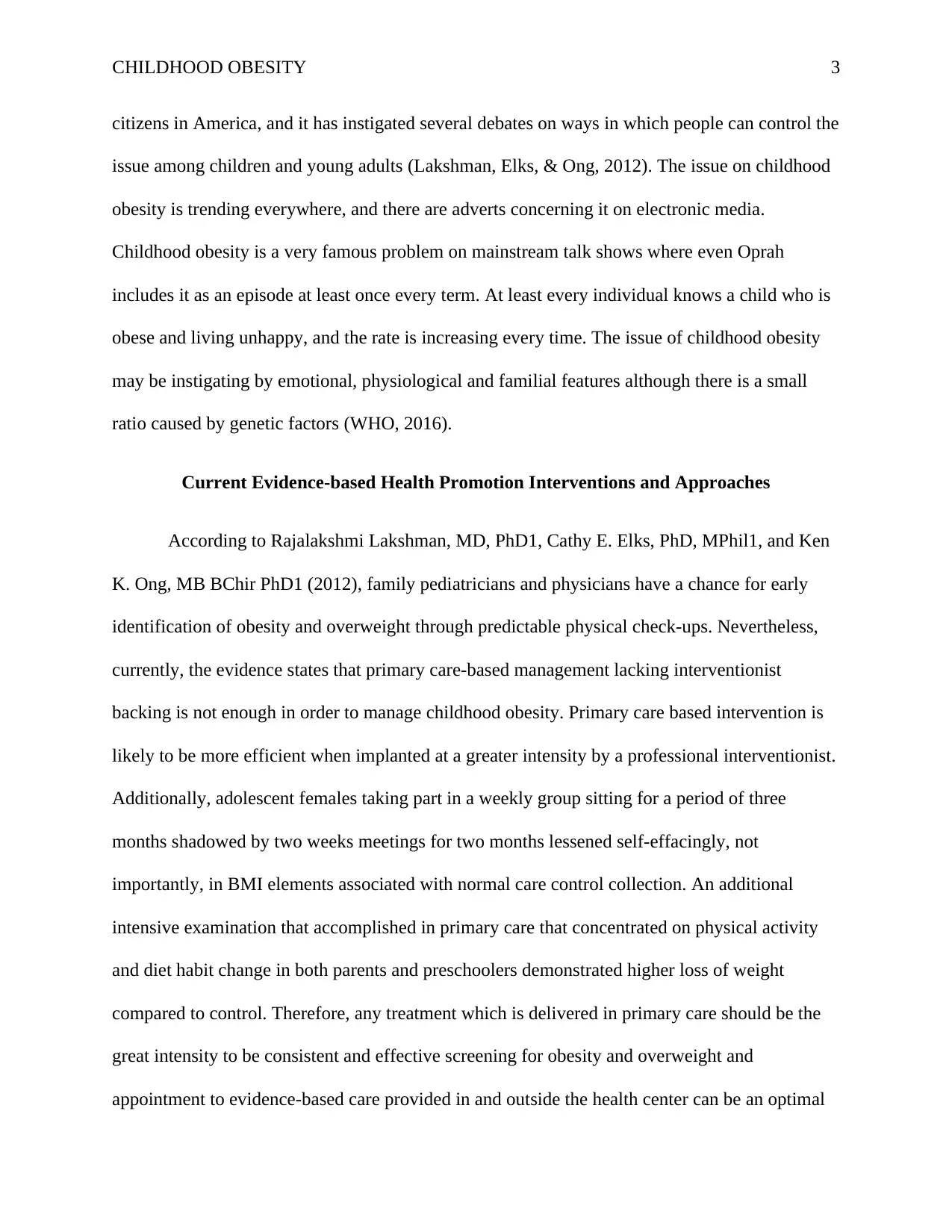
CHILDHOOD OBESITY 3
citizens in America, and it has instigated several debates on ways in which people can control the
issue among children and young adults (Lakshman, Elks, & Ong, 2012). The issue on childhood
obesity is trending everywhere, and there are adverts concerning it on electronic media.
Childhood obesity is a very famous problem on mainstream talk shows where even Oprah
includes it as an episode at least once every term. At least every individual knows a child who is
obese and living unhappy, and the rate is increasing every time. The issue of childhood obesity
may be instigating by emotional, physiological and familial features although there is a small
ratio caused by genetic factors (WHO, 2016).
Current Evidence-based Health Promotion Interventions and Approaches
According to Rajalakshmi Lakshman, MD, PhD1, Cathy E. Elks, PhD, MPhil1, and Ken
K. Ong, MB BChir PhD1 (2012), family pediatricians and physicians have a chance for early
identification of obesity and overweight through predictable physical check-ups. Nevertheless,
currently, the evidence states that primary care-based management lacking interventionist
backing is not enough in order to manage childhood obesity. Primary care based intervention is
likely to be more efficient when implanted at a greater intensity by a professional interventionist.
Additionally, adolescent females taking part in a weekly group sitting for a period of three
months shadowed by two weeks meetings for two months lessened self-effacingly, not
importantly, in BMI elements associated with normal care control collection. An additional
intensive examination that accomplished in primary care that concentrated on physical activity
and diet habit change in both parents and preschoolers demonstrated higher loss of weight
compared to control. Therefore, any treatment which is delivered in primary care should be the
great intensity to be consistent and effective screening for obesity and overweight and
appointment to evidence-based care provided in and outside the health center can be an optimal
citizens in America, and it has instigated several debates on ways in which people can control the
issue among children and young adults (Lakshman, Elks, & Ong, 2012). The issue on childhood
obesity is trending everywhere, and there are adverts concerning it on electronic media.
Childhood obesity is a very famous problem on mainstream talk shows where even Oprah
includes it as an episode at least once every term. At least every individual knows a child who is
obese and living unhappy, and the rate is increasing every time. The issue of childhood obesity
may be instigating by emotional, physiological and familial features although there is a small
ratio caused by genetic factors (WHO, 2016).
Current Evidence-based Health Promotion Interventions and Approaches
According to Rajalakshmi Lakshman, MD, PhD1, Cathy E. Elks, PhD, MPhil1, and Ken
K. Ong, MB BChir PhD1 (2012), family pediatricians and physicians have a chance for early
identification of obesity and overweight through predictable physical check-ups. Nevertheless,
currently, the evidence states that primary care-based management lacking interventionist
backing is not enough in order to manage childhood obesity. Primary care based intervention is
likely to be more efficient when implanted at a greater intensity by a professional interventionist.
Additionally, adolescent females taking part in a weekly group sitting for a period of three
months shadowed by two weeks meetings for two months lessened self-effacingly, not
importantly, in BMI elements associated with normal care control collection. An additional
intensive examination that accomplished in primary care that concentrated on physical activity
and diet habit change in both parents and preschoolers demonstrated higher loss of weight
compared to control. Therefore, any treatment which is delivered in primary care should be the
great intensity to be consistent and effective screening for obesity and overweight and
appointment to evidence-based care provided in and outside the health center can be an optimal
⊘ This is a preview!⊘
Do you want full access?
Subscribe today to unlock all pages.

Trusted by 1+ million students worldwide
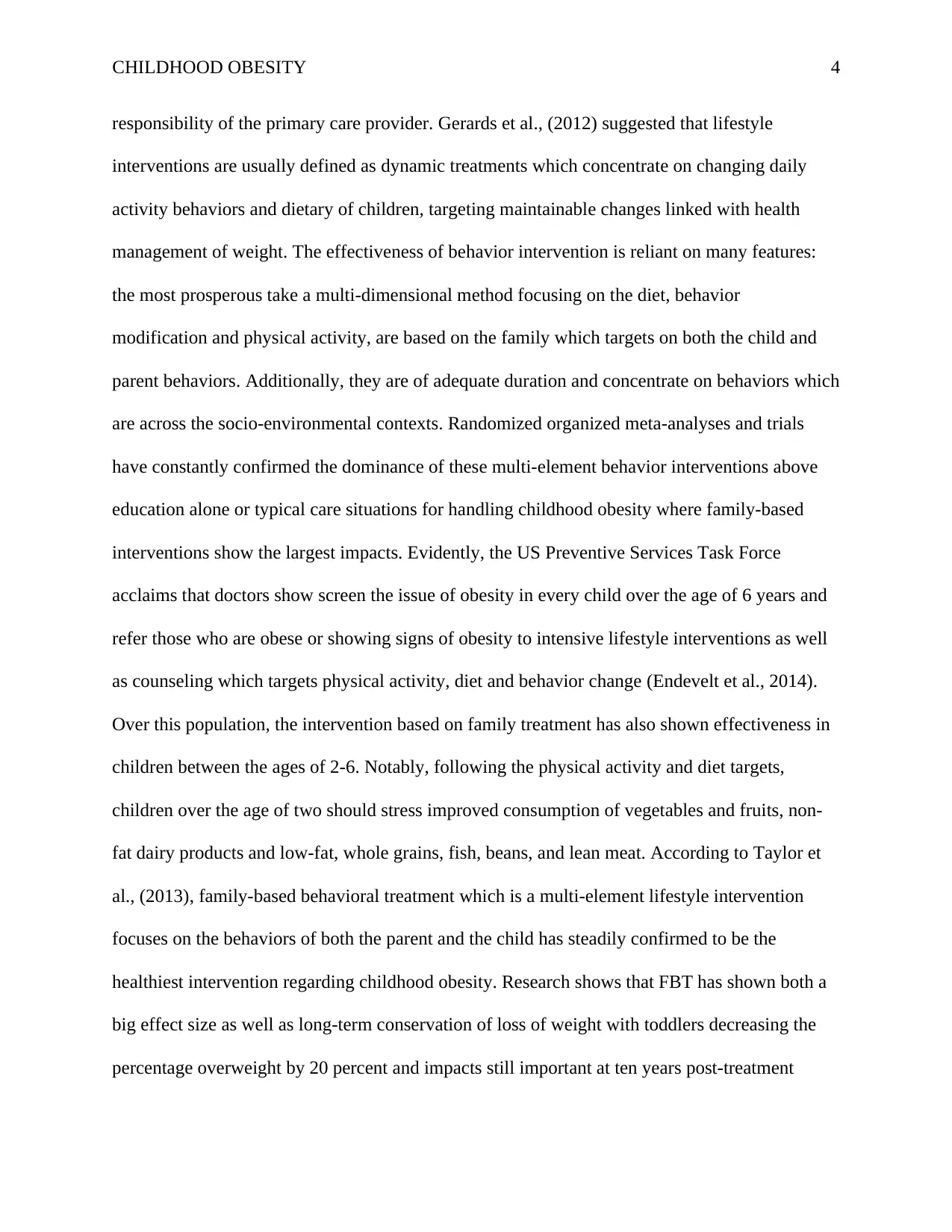
CHILDHOOD OBESITY 4
responsibility of the primary care provider. Gerards et al., (2012) suggested that lifestyle
interventions are usually defined as dynamic treatments which concentrate on changing daily
activity behaviors and dietary of children, targeting maintainable changes linked with health
management of weight. The effectiveness of behavior intervention is reliant on many features:
the most prosperous take a multi-dimensional method focusing on the diet, behavior
modification and physical activity, are based on the family which targets on both the child and
parent behaviors. Additionally, they are of adequate duration and concentrate on behaviors which
are across the socio-environmental contexts. Randomized organized meta-analyses and trials
have constantly confirmed the dominance of these multi-element behavior interventions above
education alone or typical care situations for handling childhood obesity where family-based
interventions show the largest impacts. Evidently, the US Preventive Services Task Force
acclaims that doctors show screen the issue of obesity in every child over the age of 6 years and
refer those who are obese or showing signs of obesity to intensive lifestyle interventions as well
as counseling which targets physical activity, diet and behavior change (Endevelt et al., 2014).
Over this population, the intervention based on family treatment has also shown effectiveness in
children between the ages of 2-6. Notably, following the physical activity and diet targets,
children over the age of two should stress improved consumption of vegetables and fruits, non-
fat dairy products and low-fat, whole grains, fish, beans, and lean meat. According to Taylor et
al., (2013), family-based behavioral treatment which is a multi-element lifestyle intervention
focuses on the behaviors of both the parent and the child has steadily confirmed to be the
healthiest intervention regarding childhood obesity. Research shows that FBT has shown both a
big effect size as well as long-term conservation of loss of weight with toddlers decreasing the
percentage overweight by 20 percent and impacts still important at ten years post-treatment
responsibility of the primary care provider. Gerards et al., (2012) suggested that lifestyle
interventions are usually defined as dynamic treatments which concentrate on changing daily
activity behaviors and dietary of children, targeting maintainable changes linked with health
management of weight. The effectiveness of behavior intervention is reliant on many features:
the most prosperous take a multi-dimensional method focusing on the diet, behavior
modification and physical activity, are based on the family which targets on both the child and
parent behaviors. Additionally, they are of adequate duration and concentrate on behaviors which
are across the socio-environmental contexts. Randomized organized meta-analyses and trials
have constantly confirmed the dominance of these multi-element behavior interventions above
education alone or typical care situations for handling childhood obesity where family-based
interventions show the largest impacts. Evidently, the US Preventive Services Task Force
acclaims that doctors show screen the issue of obesity in every child over the age of 6 years and
refer those who are obese or showing signs of obesity to intensive lifestyle interventions as well
as counseling which targets physical activity, diet and behavior change (Endevelt et al., 2014).
Over this population, the intervention based on family treatment has also shown effectiveness in
children between the ages of 2-6. Notably, following the physical activity and diet targets,
children over the age of two should stress improved consumption of vegetables and fruits, non-
fat dairy products and low-fat, whole grains, fish, beans, and lean meat. According to Taylor et
al., (2013), family-based behavioral treatment which is a multi-element lifestyle intervention
focuses on the behaviors of both the parent and the child has steadily confirmed to be the
healthiest intervention regarding childhood obesity. Research shows that FBT has shown both a
big effect size as well as long-term conservation of loss of weight with toddlers decreasing the
percentage overweight by 20 percent and impacts still important at ten years post-treatment
Paraphrase This Document
Need a fresh take? Get an instant paraphrase of this document with our AI Paraphraser
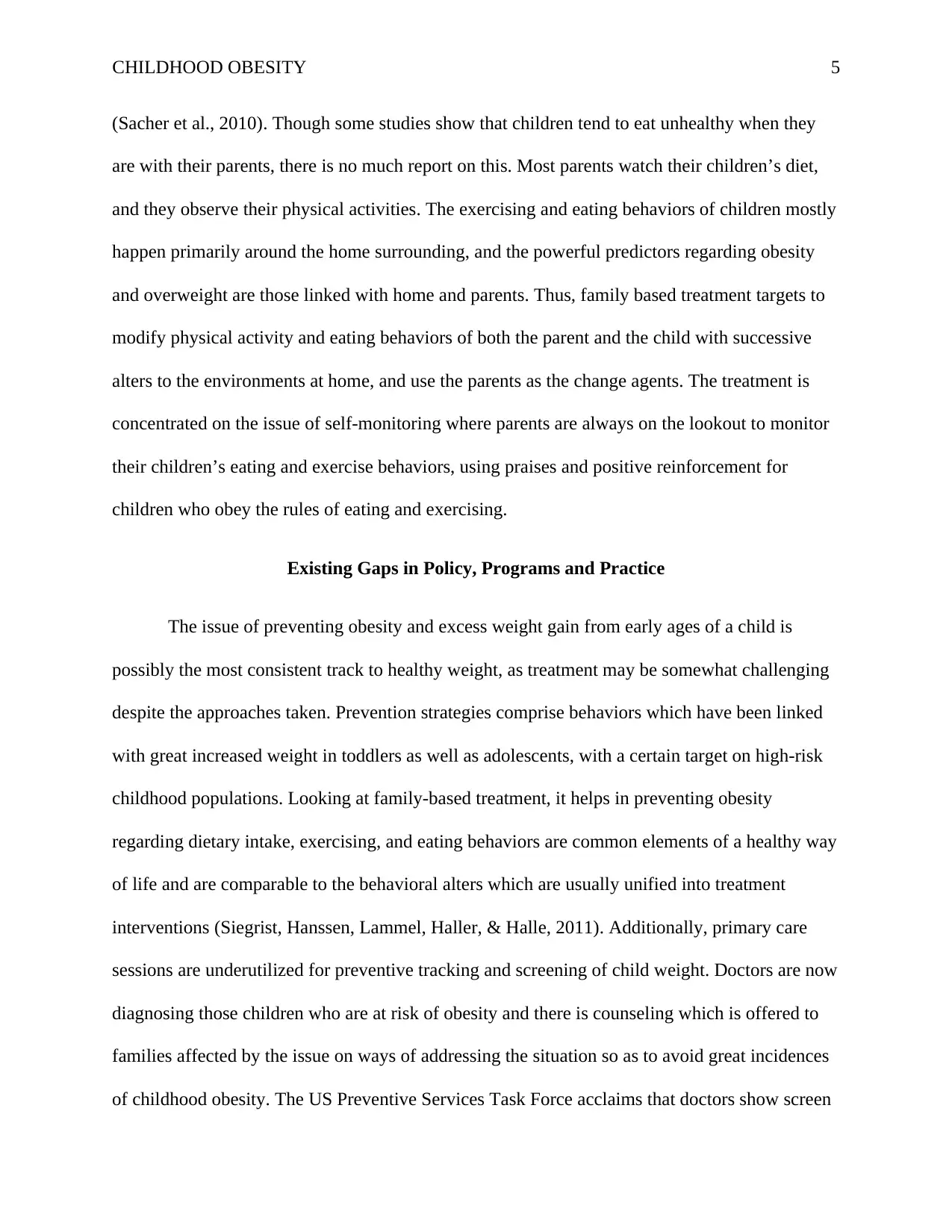
CHILDHOOD OBESITY 5
(Sacher et al., 2010). Though some studies show that children tend to eat unhealthy when they
are with their parents, there is no much report on this. Most parents watch their children’s diet,
and they observe their physical activities. The exercising and eating behaviors of children mostly
happen primarily around the home surrounding, and the powerful predictors regarding obesity
and overweight are those linked with home and parents. Thus, family based treatment targets to
modify physical activity and eating behaviors of both the parent and the child with successive
alters to the environments at home, and use the parents as the change agents. The treatment is
concentrated on the issue of self-monitoring where parents are always on the lookout to monitor
their children’s eating and exercise behaviors, using praises and positive reinforcement for
children who obey the rules of eating and exercising.
Existing Gaps in Policy, Programs and Practice
The issue of preventing obesity and excess weight gain from early ages of a child is
possibly the most consistent track to healthy weight, as treatment may be somewhat challenging
despite the approaches taken. Prevention strategies comprise behaviors which have been linked
with great increased weight in toddlers as well as adolescents, with a certain target on high-risk
childhood populations. Looking at family-based treatment, it helps in preventing obesity
regarding dietary intake, exercising, and eating behaviors are common elements of a healthy way
of life and are comparable to the behavioral alters which are usually unified into treatment
interventions (Siegrist, Hanssen, Lammel, Haller, & Halle, 2011). Additionally, primary care
sessions are underutilized for preventive tracking and screening of child weight. Doctors are now
diagnosing those children who are at risk of obesity and there is counseling which is offered to
families affected by the issue on ways of addressing the situation so as to avoid great incidences
of childhood obesity. The US Preventive Services Task Force acclaims that doctors show screen
(Sacher et al., 2010). Though some studies show that children tend to eat unhealthy when they
are with their parents, there is no much report on this. Most parents watch their children’s diet,
and they observe their physical activities. The exercising and eating behaviors of children mostly
happen primarily around the home surrounding, and the powerful predictors regarding obesity
and overweight are those linked with home and parents. Thus, family based treatment targets to
modify physical activity and eating behaviors of both the parent and the child with successive
alters to the environments at home, and use the parents as the change agents. The treatment is
concentrated on the issue of self-monitoring where parents are always on the lookout to monitor
their children’s eating and exercise behaviors, using praises and positive reinforcement for
children who obey the rules of eating and exercising.
Existing Gaps in Policy, Programs and Practice
The issue of preventing obesity and excess weight gain from early ages of a child is
possibly the most consistent track to healthy weight, as treatment may be somewhat challenging
despite the approaches taken. Prevention strategies comprise behaviors which have been linked
with great increased weight in toddlers as well as adolescents, with a certain target on high-risk
childhood populations. Looking at family-based treatment, it helps in preventing obesity
regarding dietary intake, exercising, and eating behaviors are common elements of a healthy way
of life and are comparable to the behavioral alters which are usually unified into treatment
interventions (Siegrist, Hanssen, Lammel, Haller, & Halle, 2011). Additionally, primary care
sessions are underutilized for preventive tracking and screening of child weight. Doctors are now
diagnosing those children who are at risk of obesity and there is counseling which is offered to
families affected by the issue on ways of addressing the situation so as to avoid great incidences
of childhood obesity. The US Preventive Services Task Force acclaims that doctors show screen
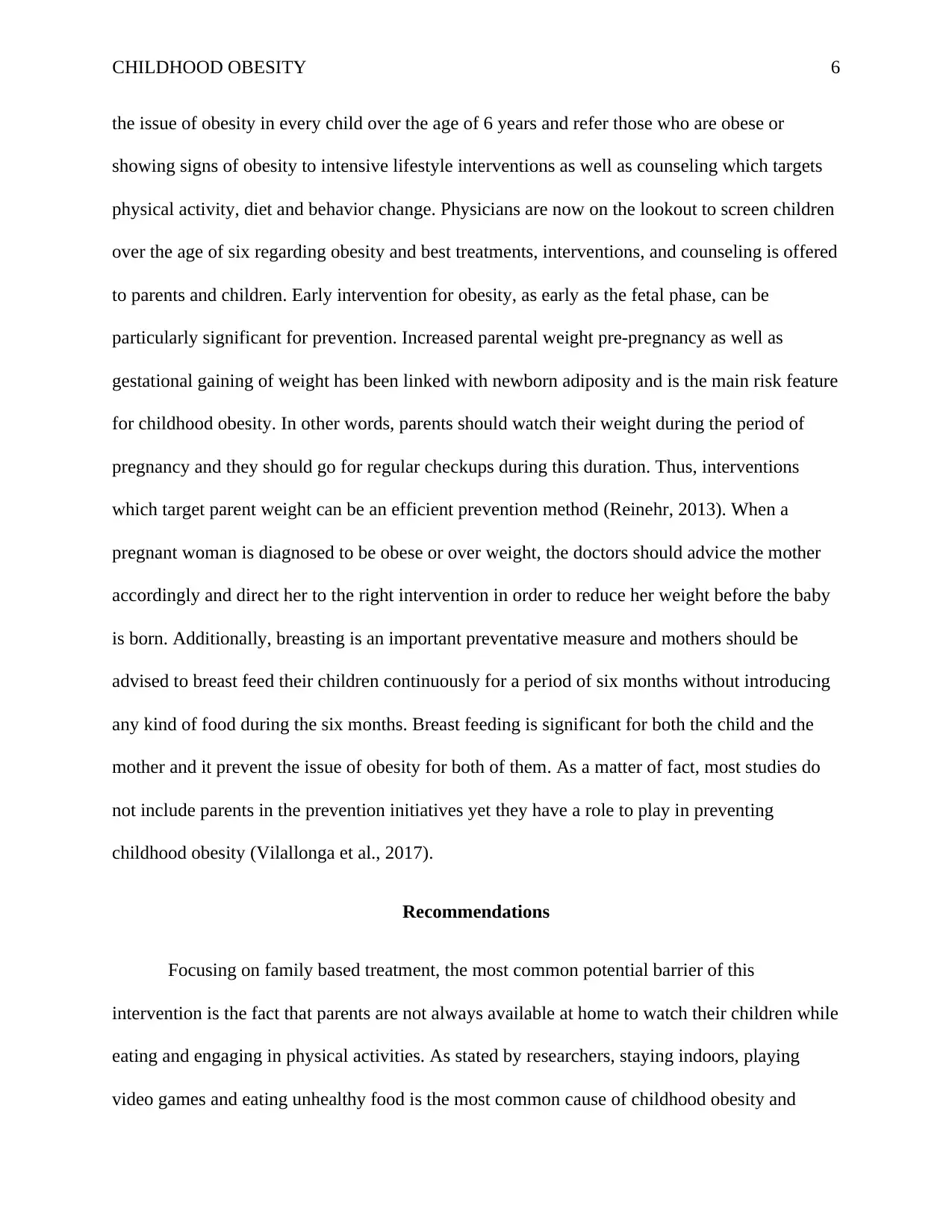
CHILDHOOD OBESITY 6
the issue of obesity in every child over the age of 6 years and refer those who are obese or
showing signs of obesity to intensive lifestyle interventions as well as counseling which targets
physical activity, diet and behavior change. Physicians are now on the lookout to screen children
over the age of six regarding obesity and best treatments, interventions, and counseling is offered
to parents and children. Early intervention for obesity, as early as the fetal phase, can be
particularly significant for prevention. Increased parental weight pre-pregnancy as well as
gestational gaining of weight has been linked with newborn adiposity and is the main risk feature
for childhood obesity. In other words, parents should watch their weight during the period of
pregnancy and they should go for regular checkups during this duration. Thus, interventions
which target parent weight can be an efficient prevention method (Reinehr, 2013). When a
pregnant woman is diagnosed to be obese or over weight, the doctors should advice the mother
accordingly and direct her to the right intervention in order to reduce her weight before the baby
is born. Additionally, breasting is an important preventative measure and mothers should be
advised to breast feed their children continuously for a period of six months without introducing
any kind of food during the six months. Breast feeding is significant for both the child and the
mother and it prevent the issue of obesity for both of them. As a matter of fact, most studies do
not include parents in the prevention initiatives yet they have a role to play in preventing
childhood obesity (Vilallonga et al., 2017).
Recommendations
Focusing on family based treatment, the most common potential barrier of this
intervention is the fact that parents are not always available at home to watch their children while
eating and engaging in physical activities. As stated by researchers, staying indoors, playing
video games and eating unhealthy food is the most common cause of childhood obesity and
the issue of obesity in every child over the age of 6 years and refer those who are obese or
showing signs of obesity to intensive lifestyle interventions as well as counseling which targets
physical activity, diet and behavior change. Physicians are now on the lookout to screen children
over the age of six regarding obesity and best treatments, interventions, and counseling is offered
to parents and children. Early intervention for obesity, as early as the fetal phase, can be
particularly significant for prevention. Increased parental weight pre-pregnancy as well as
gestational gaining of weight has been linked with newborn adiposity and is the main risk feature
for childhood obesity. In other words, parents should watch their weight during the period of
pregnancy and they should go for regular checkups during this duration. Thus, interventions
which target parent weight can be an efficient prevention method (Reinehr, 2013). When a
pregnant woman is diagnosed to be obese or over weight, the doctors should advice the mother
accordingly and direct her to the right intervention in order to reduce her weight before the baby
is born. Additionally, breasting is an important preventative measure and mothers should be
advised to breast feed their children continuously for a period of six months without introducing
any kind of food during the six months. Breast feeding is significant for both the child and the
mother and it prevent the issue of obesity for both of them. As a matter of fact, most studies do
not include parents in the prevention initiatives yet they have a role to play in preventing
childhood obesity (Vilallonga et al., 2017).
Recommendations
Focusing on family based treatment, the most common potential barrier of this
intervention is the fact that parents are not always available at home to watch their children while
eating and engaging in physical activities. As stated by researchers, staying indoors, playing
video games and eating unhealthy food is the most common cause of childhood obesity and
⊘ This is a preview!⊘
Do you want full access?
Subscribe today to unlock all pages.

Trusted by 1+ million students worldwide
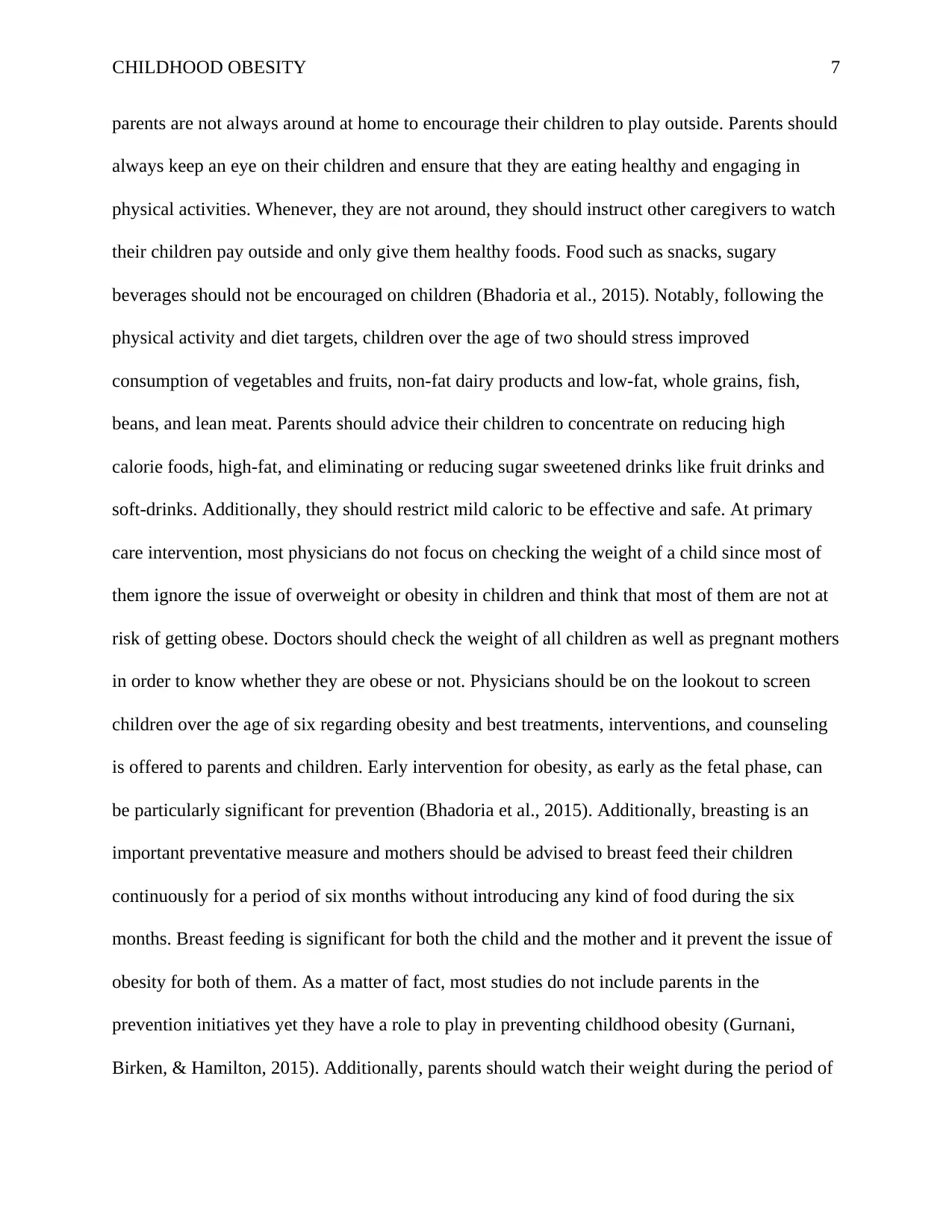
CHILDHOOD OBESITY 7
parents are not always around at home to encourage their children to play outside. Parents should
always keep an eye on their children and ensure that they are eating healthy and engaging in
physical activities. Whenever, they are not around, they should instruct other caregivers to watch
their children pay outside and only give them healthy foods. Food such as snacks, sugary
beverages should not be encouraged on children (Bhadoria et al., 2015). Notably, following the
physical activity and diet targets, children over the age of two should stress improved
consumption of vegetables and fruits, non-fat dairy products and low-fat, whole grains, fish,
beans, and lean meat. Parents should advice their children to concentrate on reducing high
calorie foods, high-fat, and eliminating or reducing sugar sweetened drinks like fruit drinks and
soft-drinks. Additionally, they should restrict mild caloric to be effective and safe. At primary
care intervention, most physicians do not focus on checking the weight of a child since most of
them ignore the issue of overweight or obesity in children and think that most of them are not at
risk of getting obese. Doctors should check the weight of all children as well as pregnant mothers
in order to know whether they are obese or not. Physicians should be on the lookout to screen
children over the age of six regarding obesity and best treatments, interventions, and counseling
is offered to parents and children. Early intervention for obesity, as early as the fetal phase, can
be particularly significant for prevention (Bhadoria et al., 2015). Additionally, breasting is an
important preventative measure and mothers should be advised to breast feed their children
continuously for a period of six months without introducing any kind of food during the six
months. Breast feeding is significant for both the child and the mother and it prevent the issue of
obesity for both of them. As a matter of fact, most studies do not include parents in the
prevention initiatives yet they have a role to play in preventing childhood obesity (Gurnani,
Birken, & Hamilton, 2015). Additionally, parents should watch their weight during the period of
parents are not always around at home to encourage their children to play outside. Parents should
always keep an eye on their children and ensure that they are eating healthy and engaging in
physical activities. Whenever, they are not around, they should instruct other caregivers to watch
their children pay outside and only give them healthy foods. Food such as snacks, sugary
beverages should not be encouraged on children (Bhadoria et al., 2015). Notably, following the
physical activity and diet targets, children over the age of two should stress improved
consumption of vegetables and fruits, non-fat dairy products and low-fat, whole grains, fish,
beans, and lean meat. Parents should advice their children to concentrate on reducing high
calorie foods, high-fat, and eliminating or reducing sugar sweetened drinks like fruit drinks and
soft-drinks. Additionally, they should restrict mild caloric to be effective and safe. At primary
care intervention, most physicians do not focus on checking the weight of a child since most of
them ignore the issue of overweight or obesity in children and think that most of them are not at
risk of getting obese. Doctors should check the weight of all children as well as pregnant mothers
in order to know whether they are obese or not. Physicians should be on the lookout to screen
children over the age of six regarding obesity and best treatments, interventions, and counseling
is offered to parents and children. Early intervention for obesity, as early as the fetal phase, can
be particularly significant for prevention (Bhadoria et al., 2015). Additionally, breasting is an
important preventative measure and mothers should be advised to breast feed their children
continuously for a period of six months without introducing any kind of food during the six
months. Breast feeding is significant for both the child and the mother and it prevent the issue of
obesity for both of them. As a matter of fact, most studies do not include parents in the
prevention initiatives yet they have a role to play in preventing childhood obesity (Gurnani,
Birken, & Hamilton, 2015). Additionally, parents should watch their weight during the period of
Paraphrase This Document
Need a fresh take? Get an instant paraphrase of this document with our AI Paraphraser
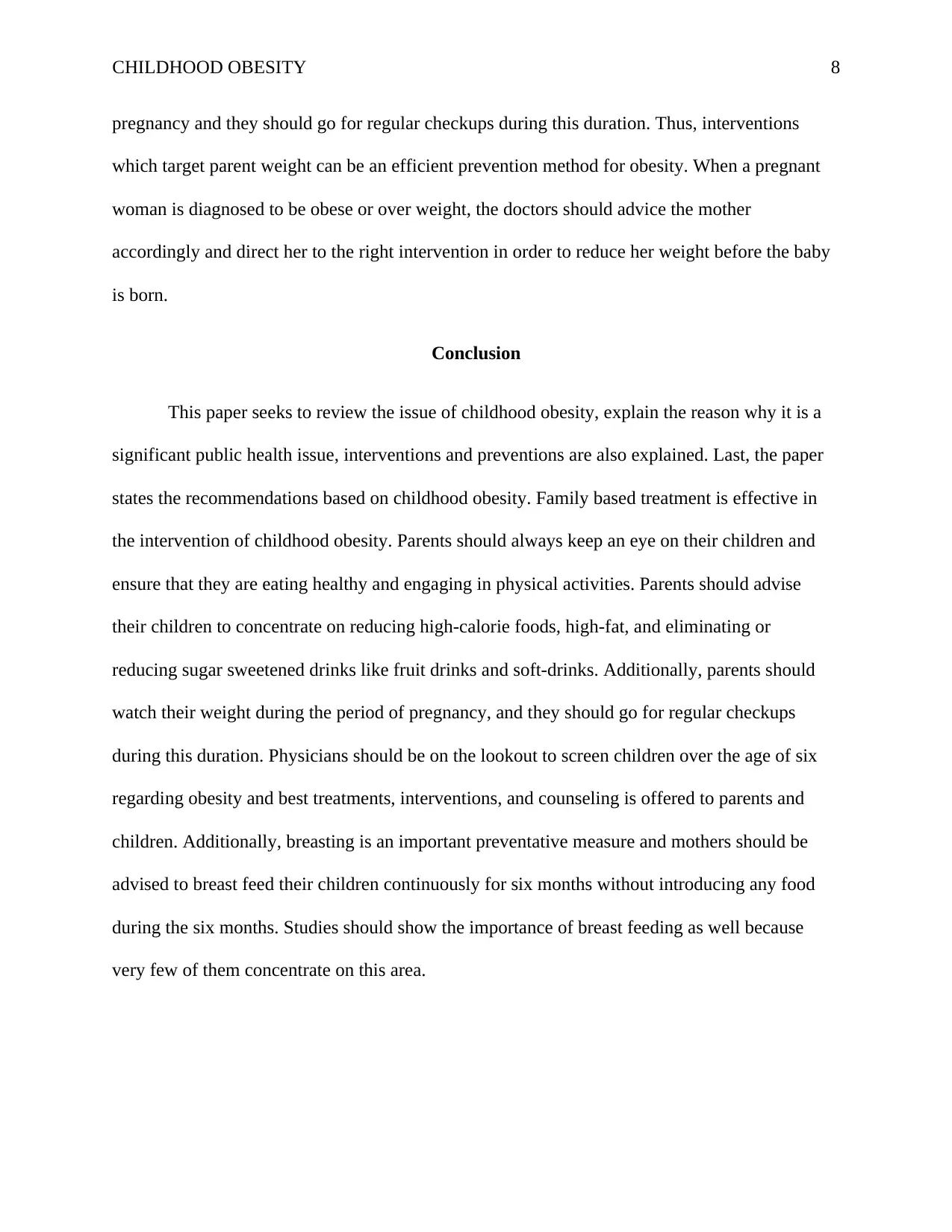
CHILDHOOD OBESITY 8
pregnancy and they should go for regular checkups during this duration. Thus, interventions
which target parent weight can be an efficient prevention method for obesity. When a pregnant
woman is diagnosed to be obese or over weight, the doctors should advice the mother
accordingly and direct her to the right intervention in order to reduce her weight before the baby
is born.
Conclusion
This paper seeks to review the issue of childhood obesity, explain the reason why it is a
significant public health issue, interventions and preventions are also explained. Last, the paper
states the recommendations based on childhood obesity. Family based treatment is effective in
the intervention of childhood obesity. Parents should always keep an eye on their children and
ensure that they are eating healthy and engaging in physical activities. Parents should advise
their children to concentrate on reducing high-calorie foods, high-fat, and eliminating or
reducing sugar sweetened drinks like fruit drinks and soft-drinks. Additionally, parents should
watch their weight during the period of pregnancy, and they should go for regular checkups
during this duration. Physicians should be on the lookout to screen children over the age of six
regarding obesity and best treatments, interventions, and counseling is offered to parents and
children. Additionally, breasting is an important preventative measure and mothers should be
advised to breast feed their children continuously for six months without introducing any food
during the six months. Studies should show the importance of breast feeding as well because
very few of them concentrate on this area.
pregnancy and they should go for regular checkups during this duration. Thus, interventions
which target parent weight can be an efficient prevention method for obesity. When a pregnant
woman is diagnosed to be obese or over weight, the doctors should advice the mother
accordingly and direct her to the right intervention in order to reduce her weight before the baby
is born.
Conclusion
This paper seeks to review the issue of childhood obesity, explain the reason why it is a
significant public health issue, interventions and preventions are also explained. Last, the paper
states the recommendations based on childhood obesity. Family based treatment is effective in
the intervention of childhood obesity. Parents should always keep an eye on their children and
ensure that they are eating healthy and engaging in physical activities. Parents should advise
their children to concentrate on reducing high-calorie foods, high-fat, and eliminating or
reducing sugar sweetened drinks like fruit drinks and soft-drinks. Additionally, parents should
watch their weight during the period of pregnancy, and they should go for regular checkups
during this duration. Physicians should be on the lookout to screen children over the age of six
regarding obesity and best treatments, interventions, and counseling is offered to parents and
children. Additionally, breasting is an important preventative measure and mothers should be
advised to breast feed their children continuously for six months without introducing any food
during the six months. Studies should show the importance of breast feeding as well because
very few of them concentrate on this area.
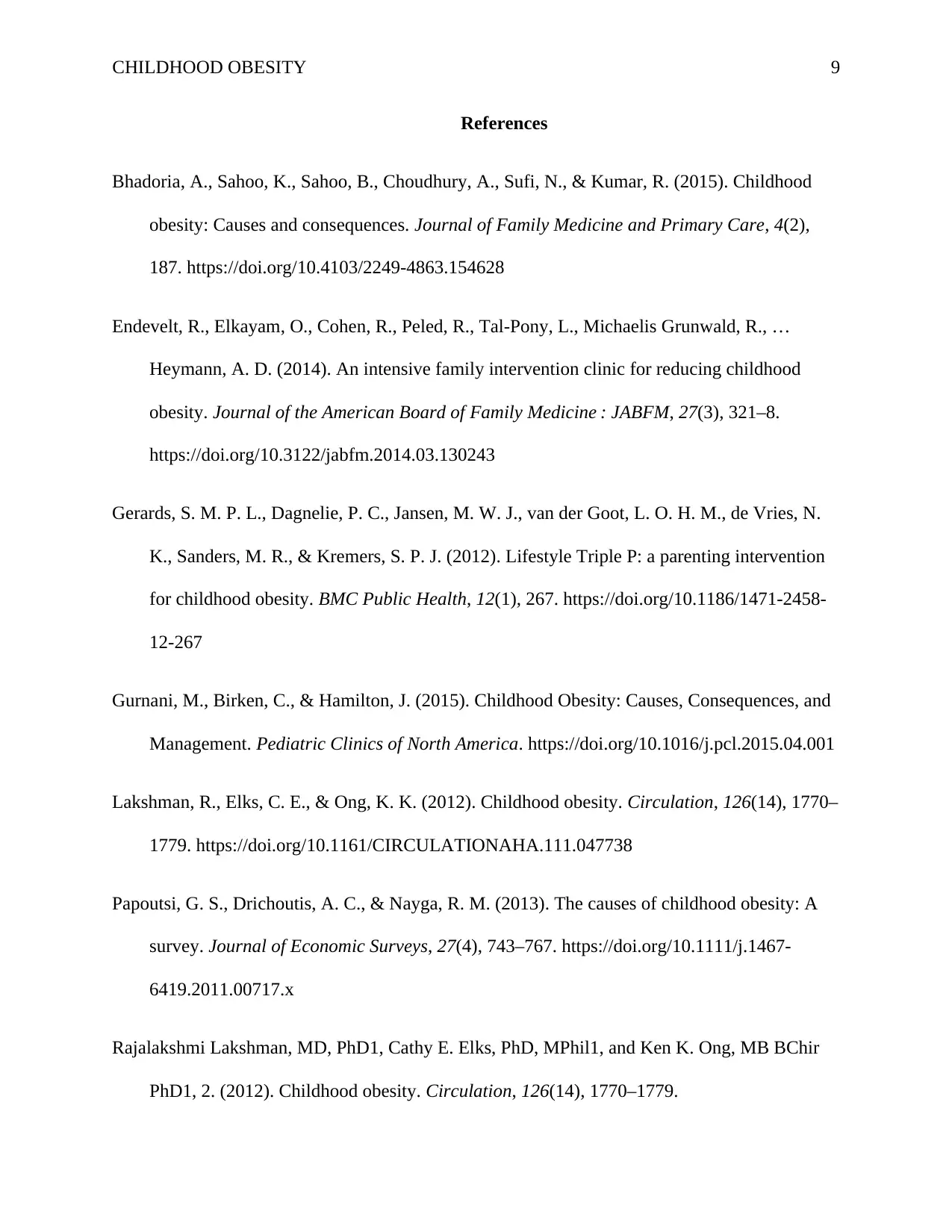
CHILDHOOD OBESITY 9
References
Bhadoria, A., Sahoo, K., Sahoo, B., Choudhury, A., Sufi, N., & Kumar, R. (2015). Childhood
obesity: Causes and consequences. Journal of Family Medicine and Primary Care, 4(2),
187. https://doi.org/10.4103/2249-4863.154628
Endevelt, R., Elkayam, O., Cohen, R., Peled, R., Tal-Pony, L., Michaelis Grunwald, R., …
Heymann, A. D. (2014). An intensive family intervention clinic for reducing childhood
obesity. Journal of the American Board of Family Medicine : JABFM, 27(3), 321–8.
https://doi.org/10.3122/jabfm.2014.03.130243
Gerards, S. M. P. L., Dagnelie, P. C., Jansen, M. W. J., van der Goot, L. O. H. M., de Vries, N.
K., Sanders, M. R., & Kremers, S. P. J. (2012). Lifestyle Triple P: a parenting intervention
for childhood obesity. BMC Public Health, 12(1), 267. https://doi.org/10.1186/1471-2458-
12-267
Gurnani, M., Birken, C., & Hamilton, J. (2015). Childhood Obesity: Causes, Consequences, and
Management. Pediatric Clinics of North America. https://doi.org/10.1016/j.pcl.2015.04.001
Lakshman, R., Elks, C. E., & Ong, K. K. (2012). Childhood obesity. Circulation, 126(14), 1770–
1779. https://doi.org/10.1161/CIRCULATIONAHA.111.047738
Papoutsi, G. S., Drichoutis, A. C., & Nayga, R. M. (2013). The causes of childhood obesity: A
survey. Journal of Economic Surveys, 27(4), 743–767. https://doi.org/10.1111/j.1467-
6419.2011.00717.x
Rajalakshmi Lakshman, MD, PhD1, Cathy E. Elks, PhD, MPhil1, and Ken K. Ong, MB BChir
PhD1, 2. (2012). Childhood obesity. Circulation, 126(14), 1770–1779.
References
Bhadoria, A., Sahoo, K., Sahoo, B., Choudhury, A., Sufi, N., & Kumar, R. (2015). Childhood
obesity: Causes and consequences. Journal of Family Medicine and Primary Care, 4(2),
187. https://doi.org/10.4103/2249-4863.154628
Endevelt, R., Elkayam, O., Cohen, R., Peled, R., Tal-Pony, L., Michaelis Grunwald, R., …
Heymann, A. D. (2014). An intensive family intervention clinic for reducing childhood
obesity. Journal of the American Board of Family Medicine : JABFM, 27(3), 321–8.
https://doi.org/10.3122/jabfm.2014.03.130243
Gerards, S. M. P. L., Dagnelie, P. C., Jansen, M. W. J., van der Goot, L. O. H. M., de Vries, N.
K., Sanders, M. R., & Kremers, S. P. J. (2012). Lifestyle Triple P: a parenting intervention
for childhood obesity. BMC Public Health, 12(1), 267. https://doi.org/10.1186/1471-2458-
12-267
Gurnani, M., Birken, C., & Hamilton, J. (2015). Childhood Obesity: Causes, Consequences, and
Management. Pediatric Clinics of North America. https://doi.org/10.1016/j.pcl.2015.04.001
Lakshman, R., Elks, C. E., & Ong, K. K. (2012). Childhood obesity. Circulation, 126(14), 1770–
1779. https://doi.org/10.1161/CIRCULATIONAHA.111.047738
Papoutsi, G. S., Drichoutis, A. C., & Nayga, R. M. (2013). The causes of childhood obesity: A
survey. Journal of Economic Surveys, 27(4), 743–767. https://doi.org/10.1111/j.1467-
6419.2011.00717.x
Rajalakshmi Lakshman, MD, PhD1, Cathy E. Elks, PhD, MPhil1, and Ken K. Ong, MB BChir
PhD1, 2. (2012). Childhood obesity. Circulation, 126(14), 1770–1779.
⊘ This is a preview!⊘
Do you want full access?
Subscribe today to unlock all pages.

Trusted by 1+ million students worldwide
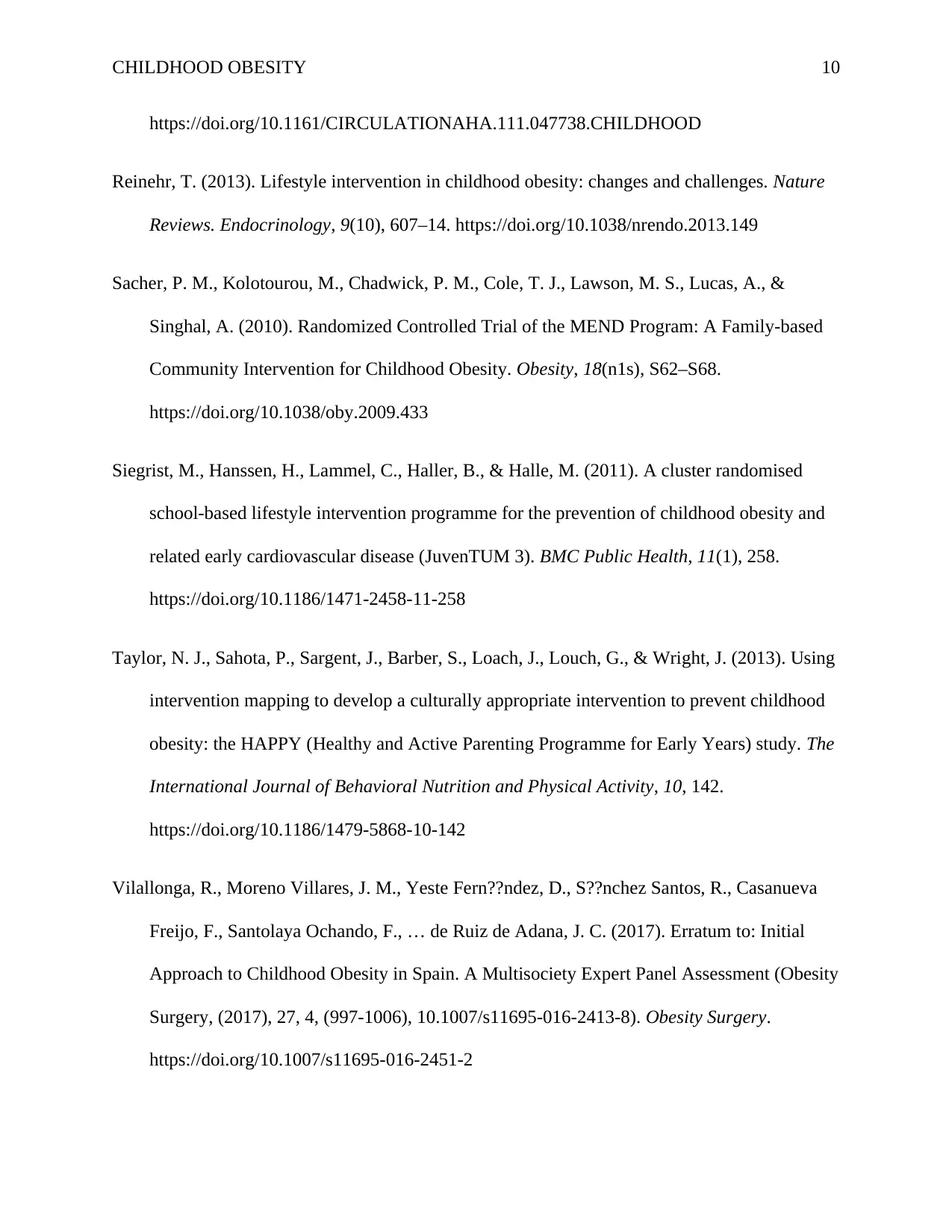
CHILDHOOD OBESITY 10
https://doi.org/10.1161/CIRCULATIONAHA.111.047738.CHILDHOOD
Reinehr, T. (2013). Lifestyle intervention in childhood obesity: changes and challenges. Nature
Reviews. Endocrinology, 9(10), 607–14. https://doi.org/10.1038/nrendo.2013.149
Sacher, P. M., Kolotourou, M., Chadwick, P. M., Cole, T. J., Lawson, M. S., Lucas, A., &
Singhal, A. (2010). Randomized Controlled Trial of the MEND Program: A Family-based
Community Intervention for Childhood Obesity. Obesity, 18(n1s), S62–S68.
https://doi.org/10.1038/oby.2009.433
Siegrist, M., Hanssen, H., Lammel, C., Haller, B., & Halle, M. (2011). A cluster randomised
school-based lifestyle intervention programme for the prevention of childhood obesity and
related early cardiovascular disease (JuvenTUM 3). BMC Public Health, 11(1), 258.
https://doi.org/10.1186/1471-2458-11-258
Taylor, N. J., Sahota, P., Sargent, J., Barber, S., Loach, J., Louch, G., & Wright, J. (2013). Using
intervention mapping to develop a culturally appropriate intervention to prevent childhood
obesity: the HAPPY (Healthy and Active Parenting Programme for Early Years) study. The
International Journal of Behavioral Nutrition and Physical Activity, 10, 142.
https://doi.org/10.1186/1479-5868-10-142
Vilallonga, R., Moreno Villares, J. M., Yeste Fern??ndez, D., S??nchez Santos, R., Casanueva
Freijo, F., Santolaya Ochando, F., … de Ruiz de Adana, J. C. (2017). Erratum to: Initial
Approach to Childhood Obesity in Spain. A Multisociety Expert Panel Assessment (Obesity
Surgery, (2017), 27, 4, (997-1006), 10.1007/s11695-016-2413-8). Obesity Surgery.
https://doi.org/10.1007/s11695-016-2451-2
https://doi.org/10.1161/CIRCULATIONAHA.111.047738.CHILDHOOD
Reinehr, T. (2013). Lifestyle intervention in childhood obesity: changes and challenges. Nature
Reviews. Endocrinology, 9(10), 607–14. https://doi.org/10.1038/nrendo.2013.149
Sacher, P. M., Kolotourou, M., Chadwick, P. M., Cole, T. J., Lawson, M. S., Lucas, A., &
Singhal, A. (2010). Randomized Controlled Trial of the MEND Program: A Family-based
Community Intervention for Childhood Obesity. Obesity, 18(n1s), S62–S68.
https://doi.org/10.1038/oby.2009.433
Siegrist, M., Hanssen, H., Lammel, C., Haller, B., & Halle, M. (2011). A cluster randomised
school-based lifestyle intervention programme for the prevention of childhood obesity and
related early cardiovascular disease (JuvenTUM 3). BMC Public Health, 11(1), 258.
https://doi.org/10.1186/1471-2458-11-258
Taylor, N. J., Sahota, P., Sargent, J., Barber, S., Loach, J., Louch, G., & Wright, J. (2013). Using
intervention mapping to develop a culturally appropriate intervention to prevent childhood
obesity: the HAPPY (Healthy and Active Parenting Programme for Early Years) study. The
International Journal of Behavioral Nutrition and Physical Activity, 10, 142.
https://doi.org/10.1186/1479-5868-10-142
Vilallonga, R., Moreno Villares, J. M., Yeste Fern??ndez, D., S??nchez Santos, R., Casanueva
Freijo, F., Santolaya Ochando, F., … de Ruiz de Adana, J. C. (2017). Erratum to: Initial
Approach to Childhood Obesity in Spain. A Multisociety Expert Panel Assessment (Obesity
Surgery, (2017), 27, 4, (997-1006), 10.1007/s11695-016-2413-8). Obesity Surgery.
https://doi.org/10.1007/s11695-016-2451-2
Paraphrase This Document
Need a fresh take? Get an instant paraphrase of this document with our AI Paraphraser
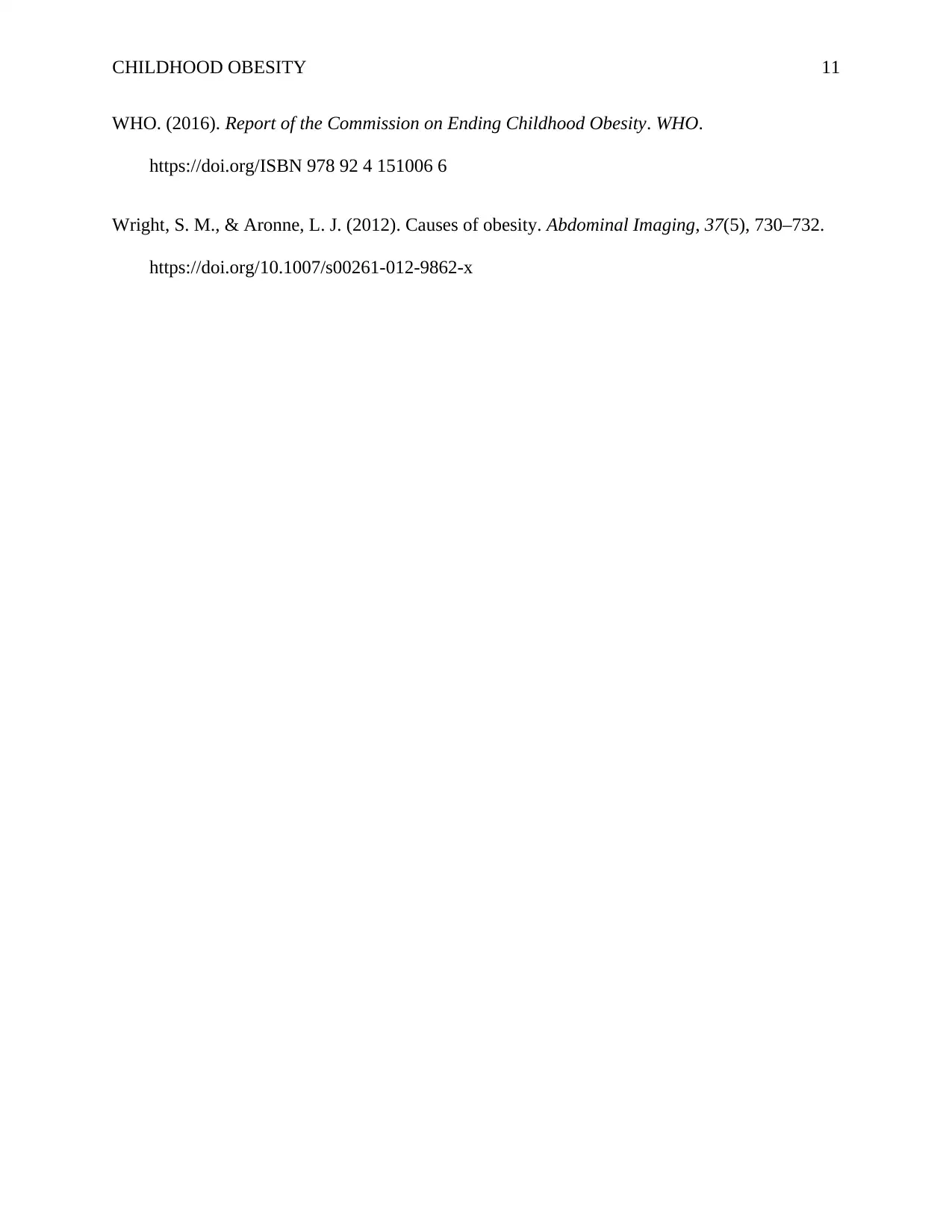
CHILDHOOD OBESITY 11
WHO. (2016). Report of the Commission on Ending Childhood Obesity. WHO.
https://doi.org/ISBN 978 92 4 151006 6
Wright, S. M., & Aronne, L. J. (2012). Causes of obesity. Abdominal Imaging, 37(5), 730–732.
https://doi.org/10.1007/s00261-012-9862-x
WHO. (2016). Report of the Commission on Ending Childhood Obesity. WHO.
https://doi.org/ISBN 978 92 4 151006 6
Wright, S. M., & Aronne, L. J. (2012). Causes of obesity. Abdominal Imaging, 37(5), 730–732.
https://doi.org/10.1007/s00261-012-9862-x
1 out of 11
Related Documents
Your All-in-One AI-Powered Toolkit for Academic Success.
+13062052269
info@desklib.com
Available 24*7 on WhatsApp / Email
![[object Object]](/_next/static/media/star-bottom.7253800d.svg)
Unlock your academic potential
Copyright © 2020–2025 A2Z Services. All Rights Reserved. Developed and managed by ZUCOL.





